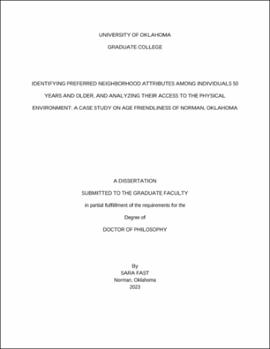| dc.contributor.advisor | Lowery, Bryce | |
| dc.contributor.author | Fast, Sara | |
| dc.date.accessioned | 2023-12-15T19:25:50Z | |
| dc.date.available | 2023-12-15T19:25:50Z | |
| dc.date.issued | 2023-12-15 | |
| dc.identifier.uri | https://hdl.handle.net/11244/340055 | |
| dc.description.abstract | The number of people aged 65-and-older has been growing worldwide and in the United States. The needs of these aging individuals will affect the communities in which they live. Faced with this drastic shift in the older adults population, the idea of aging in place was proposed by the World Health Organization (WHO) to focus on making the older adults’ homes and communities safe by tailoring them to their well-being and needs. By aging in place, older individuals can remain in communities for as long as possible while keeping their autonomy and social connections.
The concept of aging-in-place has been studied thoroughly in different fields like gerontology, social policy, and public health. By integrating a planning perspective on this interdisciplinary research topic, this dissertation focuses on the neighborhood preferences of individuals aged 50 or older in Norman, Oklahoma as well as their access to age friendly amenities through conducting a survey and spatial analysis. Successful aging in communities is not possible without access to reliable transportation, health services, recreational opportunities, physical and social support systems, and a wide variety of amenities. However, this study’s findings demonstrate that currently there is a gap between what individuals 50 years and above need to age in their neighborhoods and the current built environment attributes. Understanding this gap and the challenges these individuals face to age in their communities could help planners and designers develop policy and design recommendations to improve age friendliness of neighborhoods.
Keywords: Age friendliness, Aging in Place, Residential Location Choice, Built Environment Attributes, Spatial Analysis, Older Adults, Middle Aged Adults | en_US |
| dc.language | en_US | en_US |
| dc.subject | Age friendliness | en_US |
| dc.subject | Aging in Place | en_US |
| dc.subject | Residential Location Choice | en_US |
| dc.subject | Spatial Analysis | en_US |
| dc.subject | Urban and Regional Planning. | en_US |
| dc.title | Identifying Preferred Neighborhood Attributes Among Individuals 50 Years and Older, and Analyzing Their Access to the Physical Environment: A Case Study on Age Friendliness of Norman, Oklahoma | en_US |
| dc.contributor.committeeMember | Pilat, Stephanie | |
| dc.contributor.committeeMember | Warnken, Charles | |
| dc.contributor.committeeMember | Purcell, Darren | |
| dc.contributor.committeeMember | Boeck, David | |
| dc.date.manuscript | 2023-11-01 | |
| dc.thesis.degree | Ph.D. | en_US |
| ou.group | Christopher C. Gibbs College of Architecture | en_US |
